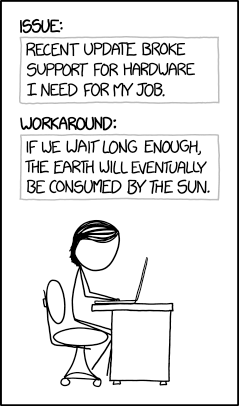
We work in a communications industry.
We create and maintain systems to move information around in order to get things done. That information moves between people and systems in combinations and configurations too numerous to count. In spite of that, we don’t do that great a job of communicating what should be, for us, extremely important information. We tend to be really bad at communicating the architecture of our systems – structure, behavior, and most importantly, the reasons for the decisions made. It’s bad enough when we fail to adequately communicate that information to others, it’s really bad when we fail to communicate it to ourselves. I know I’ve let myself down more than once (“What was I thinking here?!”).
Over the past few days, I’ve been privileged to follow (and even contribute a bit to) a set of conversations on Twitter. Grady Booch, Ivar Jacobson, Ruth Malan, Simon Brown, and others have been discussing the need for architectural awareness and the state of communicating architecture.
This exchange between Simon, Chris Carroll and Eoin Woods sums it up well:
First and foremost, an understanding of what the role of a software architect is and why it’s important is needed. Any organization where the role is seen as either just a senior developer or (heaven help us!) some sort of Taylorist “thinker” who designs everything for the “worker bee” coders to implement, is almost guaranteed to be challenged in terms of application architecture. Resting on that foundation of shifting sand, the organization’s enterprise IT architecture (EITA) is likewise almost guaranteed to be challenged barring a remarkable series of “happy accidents”. The role (not necessarily position) of software architect is required, because software architecture is a distinct set of concerns that can either be addressed intentionally or left to emerge haphazardly out of the construction of the system.
Before we can communicate the architecture of a system, it’s necessary to understand what that is. In “Software Architecture: Central Concerns, Key Decisions”, Ruth Malan and Dana Bredemeyer defined it as high impact, systemic decisions involving (at a minimum):
- system priority setting
- system decomposition and composition
- system properties, especially cross-cutting concerns
- system fit to context
- system integrity
I don’t think it’s possible to over-emphasize the use of “system” and “systemic” in the preceding paragraphs. That being said, it’s important to understand that architectural concerns do not exist in a void. There is a cyclic relationship between the architectural concerns of a system and the system’s code. The architectural concerns guide the implementation, while the implementation defines the current state of the architecture and constrains the evolution of future state of the architecture. Code is a necessary, but insufficient source of architectural knowledge – it’s not enough. As Ruth Malan noted in the Visual Design portion (part II) of her presentation at the Software Architect Conference in London a year ago:

While the code serves as a foundation of the system, it’s also important to realize that the system exists within a larger context. There is a fractal set of systems within systems within ecosystems. Ruth illustrated this in the Intention and Reflection portion (part III) of the presentation reference above:

[Note: Take the time to view the entirety of the Intention and Reflection presentation. It’s an excellent overview of how to design the architecture of a system.]
The fractal nature of systems within systems within ecosystems is illustrated by the image at the top of the post (h/t to Ric Phillips for the reblog of it). Richard Sage‘s humorous (though only partly, I’m sure) suggestion of it as a meta-model goes a long way towards portraying the problem of a language to communicate architecture.
Not only are we dealing with a nested set of “things”, but the understanding of those things differ according to the stakeholder. For example, while the business owner might see a “web site” as one monolithic thing, the architect might see an application made up of code components depending on other applications and services running on a collection of servers. Maintaining a coherent, normalized object model of the system yet being able to present it in multiple ways (some of which might be difficult to relate) is not a trivial exercise.
Lower-level aspects of design lend themselves to automated solutions, which can increase reliability of the model by avoiding “documentation rot”. An interesting (in my opinion) aspect that can also be automated is the evolution of code over time. What can’t be parsed from the code, however, is intention and reasoning.
Another barrier to communication is the need to be both expressive and flexible (also well illustrated by Richard’s meta-model) while also being simple enough to use. UML works well on the former, but (rightly or wrongly) is perceived to fail on the latter. Simon Brown’s C4 model aims to achieve a better balance in that aspect.
At present, I don’t think we have one tool that does it all. I suspect that even with a suite of tools, that narrative documents will still be way some aspects are captured and communicated. Having a centralized store for the non-code bits (with a way to relate them back to the code) would be a great thing.
All in all, it is encouraging to see people talking about the need for architectural design and the need to communicate the aspects of that design.







